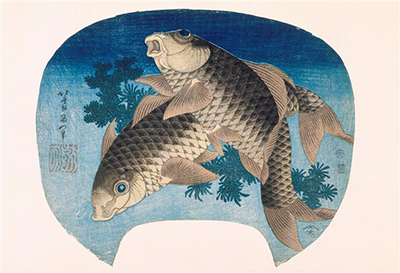Two Carps is an example of Hokusai's transition from the traditional kabuki, courtesans, and wrestlers of the early Ukiyo-e style, to works focusing on scenes of nature, of which Hokusai is most famous. Hokusai's Two Carps, a colour woodblock painting on paper, depicts two koi swimming in different directions on a blue background.
Two Carps encapsulates Hokusai's later passion for nature and icons of everyday Japanese life. Asian art often depicts carp. With its symbolic roots based in Chinese culture, belief in the spiritual character of these serene and peaceful creatures is evident throughout Asia. In Japanese culture, the carp is a symbol of good luck and fortune. Based on Chinese mythology, Buddhist's believe the carp symbolises all human suffering as we pass through life while the Zen Buddhists believe they are symbols of peace found in a single moment. In Japan, the carp is a symbol of power and strength against the travails of existence.
In Two Carps, the multi-directional path of the carp is significant. The carp swimming upstream signifies the uphill struggle towards attaining one's goals. Whereas, the carp swimming downstream is at peace for its aims have been achieved. Together, Two Carps is a representation of human struggle as a whole, where one endeavor succeeds, another arises, and so the battle of life continues.
Two Carps is an excellent example of woodblock painting. A process first introduced as a book printing method, later it was used as a way to print art. Using painted paper as a template, artisans carved blocks of wood and could then print paintings. This style was extensively used by artists in the Ukiyo-e style in the Edo period.
The Ukiyo-e style, not only being iconic of Japanese art, significantly influenced western artists and culture. While Hokusai is most widely recognised, there are other artists of the Ukiyo-e style that have made significant contributions to the art world. One of which is, Kuniyoshi, 1798-1861, while also painting the familiar motifs of the style, found widespread acclaim in his depictions of warriors and mythical creatures.




